300 mm Large Area Wire Grid Polarizers with 50 nm Half-Pitch by ArF Immersion Lithography
Abstract
:1. Introduction
2. Experiment and Simulation
2.1. Local Flare Effect
2.2. Local Flare Collection
3. Results and Discussion
3.1. LFC Result
3.2. Large-Area WGP
4. Conclusions
Author Contributions
Funding
Institutional Review Board Statement
Informed Consent Statement
Data Availability Statement
Conflicts of Interest
References
- Yu, X.J.; Kwok, H.S. Optical wire-grid polarizers at oblique angles of incidence. J. Appl. Phys. 2003, 93, 4407–4412. [Google Scholar] [CrossRef] [Green Version]
- Kuo, H.L.; Chiu, C.H.; Chen, P.C. A novel wire grid polarizer. In SID Symposium Digest of Technical Papers; Blackwell Publishing Ltd.: Oxford, UK, 2004; Volume 35, pp. 732–735. [Google Scholar]
- Gayduk, A.E.; Prinz, V.Y.; Seleznev, V.A.; Rechkunov, S.N. Large-area multilayer infrared nano-wire grid polarizers. Infrared Phys. Technol. 2016, 75, 77–81. [Google Scholar] [CrossRef]
- Ahn, S.-W.; Lee, K.-D.; Kim, J.-S.; Kim, S.H.; Park, J.-D.; Lee, S.-H.; Yoon, P.-W. Fabrication of a 50 nm half-pitch wire grid polarizer using nanoimprint lithography. Nanotechnology 2005, 16, 1874–1877. [Google Scholar] [CrossRef]
- Savas, T.A.; Schattenburg, M.L.; Carter, J.M.; Smith, H.I. Large-area achromatic interferometric lithography for 100 nm period gratings and grids. J. Vac. Sci. Technol. B 1996, 14, 4167–4170. [Google Scholar] [CrossRef]
- Chris, A.M. Measuring and modeling flare in optical lithography. In Proceedings of the Optical Microlithography XVI—International Society for Optics and Photonics, Santa Clara, CA, USA, 26 June 2003. [Google Scholar]
- Joseph, P.K. Scattered light in photolithographic lenses. In Proceedings of the Optical/Laser Microlithography VII—International Society for Optics and Photonics, San Jose, CA, USA, 17 May 1994; pp. 566–572. [Google Scholar]
- La Fontaine, B.M.; Dusa, M.V.; Acheta, A.; Chen, C.; Bourov, A.; Levinson, H.J.; van Praagh, J.; Litt, L.C.; Mulder, M.; Seltman, R.; et al. Flare and its impact on low-k1 KrF and ArF lithography. In Proceedings of the Optical Microlithography XV International Society for Optics and Photonics, Santa Clara, CA, USA, 30 July 2002. [Google Scholar]
- Yow, K.Y.; Shi, K.W. Laser grooving on narrow scribe widths on thick flip chip wafer: The challenges and its resolution. In Proceedings of the 12th Electronics Packaging Technology Conference IEEE, Singapore, 8–10 December 2010; pp. 369–372. [Google Scholar]
- Bouchoms, I.; Engelen, A.; Mulkens, J.; Boom, H.; Moerman, R.; Liebregts, P.; Sperling, F.; Thomassen, P.; Emer, W.; van Veen, M.; et al. Extending single-exposure patterning towards 38-nm half-pitch using 1.35 NA immersion. In Proceedings of the Optical Microlithography XXII International Society for Optics and Photonics, San Jose, CA, USA, 16 March 2009; Volume 7274, p. 72741K. [Google Scholar]
- Mi, X.-D.; Kessler, D.; Tutt, L.W.; Weller-Brophy, L. Low Fill-Factor Wire Grid Polarizers for LCD Backlighting. In SID Symposium Digest of Technical Papers; Blackwell Publishing Ltd.: Oxford, UK, 2005; pp. 1004–1007. [Google Scholar]
- Honda, T.; Kishikawa, Y.; Iwasaki, Y.; Ohkubo, A.; Kawashima, M.; Yoshii, M. Influence of resist blur on ultimate resolution of ArF immersion lithography. J. Micro Nanolithogr. MEMS MOEMS 2006, 5, 043004. [Google Scholar] [CrossRef]
- Lenhart, J.L.; Fischer, D.; Sambasivan, S.; Lin, E.K.; Wu, W.-L.; Guerrero, D.J.; Wang, Y.; Puligadda, R. Understanding deviations in lithographic patterns near interfaces: Characterization of bottom anti-reflective coatings (BARC) and the BARC–resist interface. Appl. Surf. Sci. 2007, 253, 4166–4175. [Google Scholar] [CrossRef]
- Osawa, M.; Yao, T.; Aoyama, H.; Ogino, K.; Hoshino, H.; Machida, Y.; Asai, S.; Arimoto, H. Correction for local flare effects approximated with double Gaussian profile in ArF lithography. J. Vac. Sci. Technol. B Microelectron. Nanometer. Struct. 2003, 21, 2806. [Google Scholar] [CrossRef]
- Zheng, Z.; Yang, Z.; Shao, C.; Ikeda, J. The Monitor Strategies of Lens Flare for Nikon ArF and KrF Scanner Machines: Simulated Results and Discussion. In Proceedings of the China Semiconductor Technology International Conference (CSTIC), Shanghai, China, 18–19 March 2019; pp. 1–3. [Google Scholar]
- Kim, S.Y.; Gwyther, J.; Manners, I.; Chaikin, P.M.; Register, R.A. Metal-Containing Block Copolymer Thin Films Yield Wire Grid Polarizers with High Aspect Ratio. Adv. Mater. 2013, 26, 791–795. [Google Scholar] [CrossRef] [PubMed]
- Shin, Y.J.; Piña-Hernandez, C.; Wu, Y.-K.; Ok, J.G.; Guo, L.J. Facile route of flexible wire grid polarizer fabrication by angled-evaporations of aluminum on two sidewalls of an imprinted nanograting. Nanotechnology 2012, 23, 344018. [Google Scholar] [CrossRef] [PubMed]
- Weber, T.; Käsebier, T.; Szeghalmi, A.; Knez, M.; Kley, E.-B.; Tünnermann, A. Iridium wire grid polarizer fabricated using atomic layer deposition. Nanoscale Res. Lett. 2011, 6, 558. [Google Scholar] [CrossRef] [PubMed] [Green Version]
- Hollowell, A.E.; Guo, L.J. Nanowire grid polarizers integrated into flexible, gas permeable, biocompatible materials and contact lenses. Adv. Opt. Mater. 2013, 1, 343–348. [Google Scholar] [CrossRef] [Green Version]
- Liu, X.; Deng, X.; Sciortino, P.; Buonanno, M.; Walters, F.; Varghese, R.; Bacon, J.; Chen, L.; O’Brie, N.; Wang, J.J. Large Area, 38 nm Half-Pitch Grating Fabrication by Using Atomic Spacer Lithography from Aluminum Wire Grids. Nano Lett. 2006, 6, 2723–2727. [Google Scholar] [CrossRef] [PubMed]
- Pang, Y.-T.; Meng, G.-W.; Zhang, L.-D.; Qin, Y.; Gao, X.-Y.; Zhao, A.-W.; Fang, Q. Arrays of Ordered Pb Nanowires and Their Optical Properties for Laminated Polarizers. Adv. Funct. Mater. 2002, 12, 719–722. [Google Scholar] [CrossRef]
- Guo, L.J. Recent progress in nanoimprint technology and its applications. J. Phys. D Appl. Phys. 2004, 37, R123–R141. [Google Scholar] [CrossRef]
- Kim, J.; Cho, S.; Jeong, M.Y. A Study on Optical Characteristic of Nano Metal Grid Polarizer Film with Different Deposition Thicknes. J. Microelectron. Packag. Soc. 2015, 22, 63–67. [Google Scholar] [CrossRef] [Green Version]
- Siefke, T.; Heusinger, M.; Hurtado, C.B.R.; Dickmann, J.; Zeitner, U.; Tünnermann, A.; Kroker, S. Line-edge roughness as a challenge for high-performance wire grid polarizers in the far ultraviolet and beyond. Opt. Express 2018, 26, 19534–19547. [Google Scholar] [CrossRef] [PubMed]
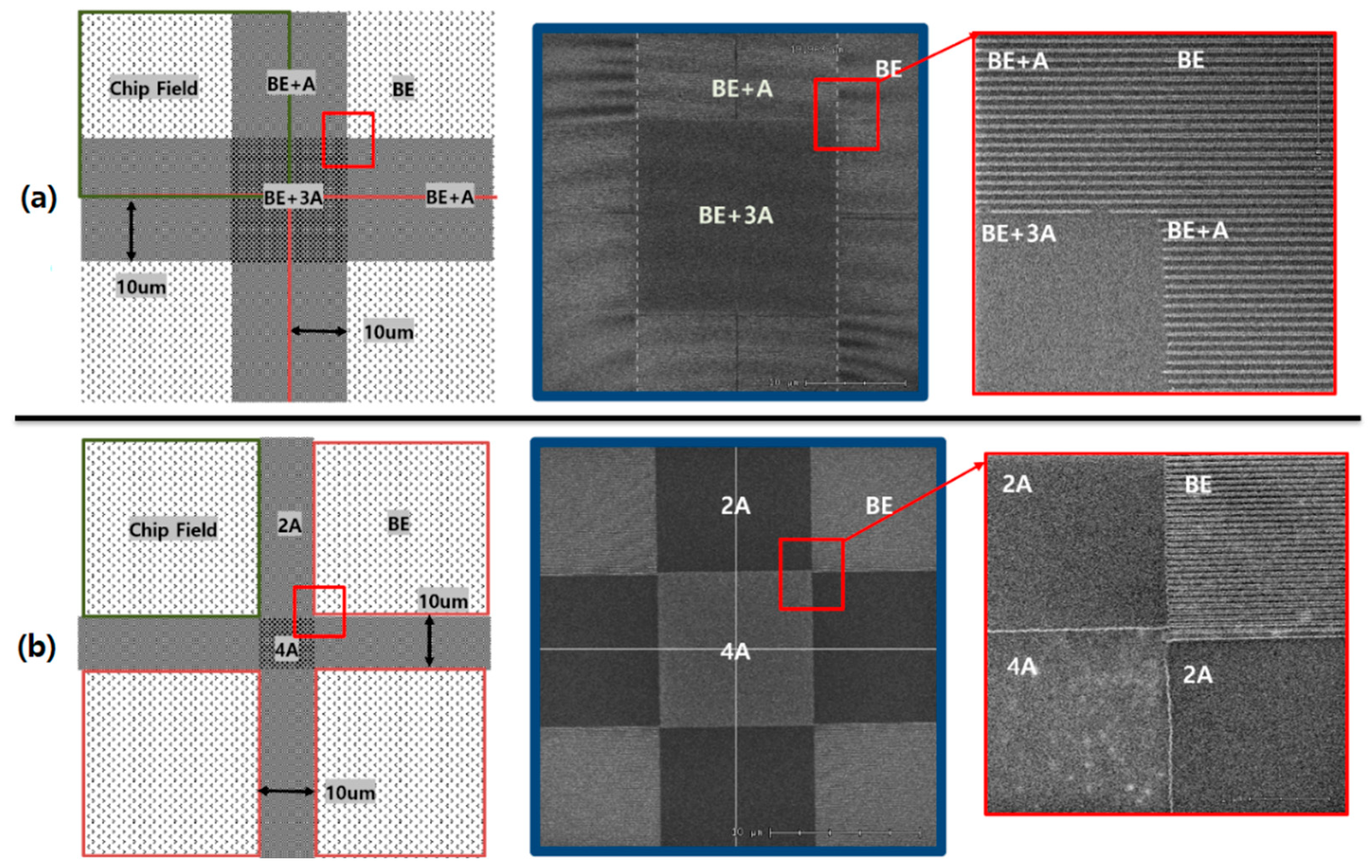


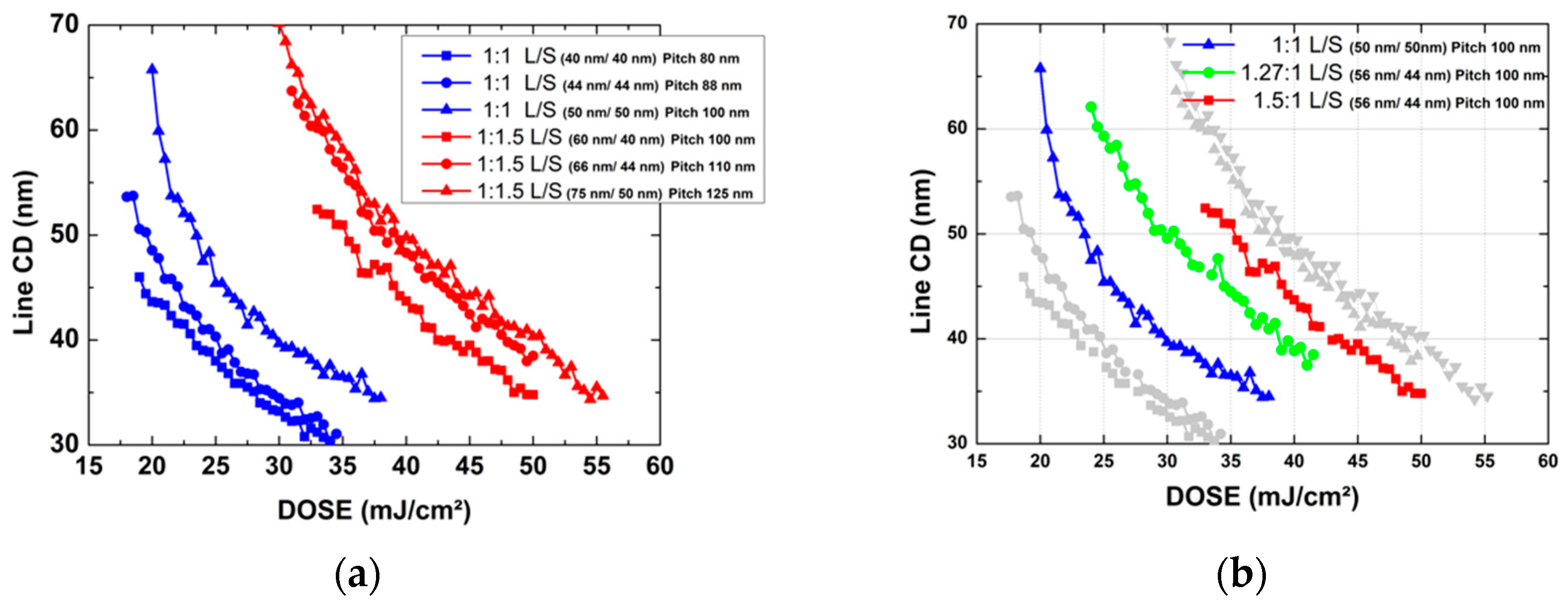
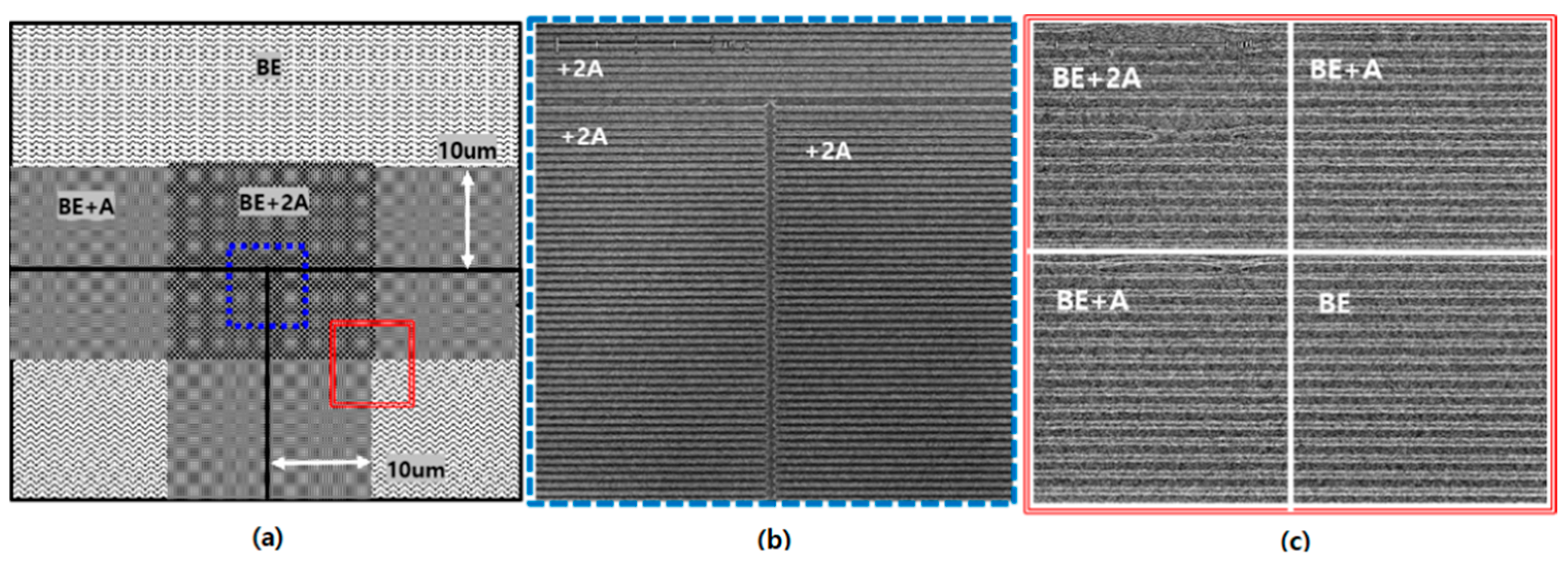
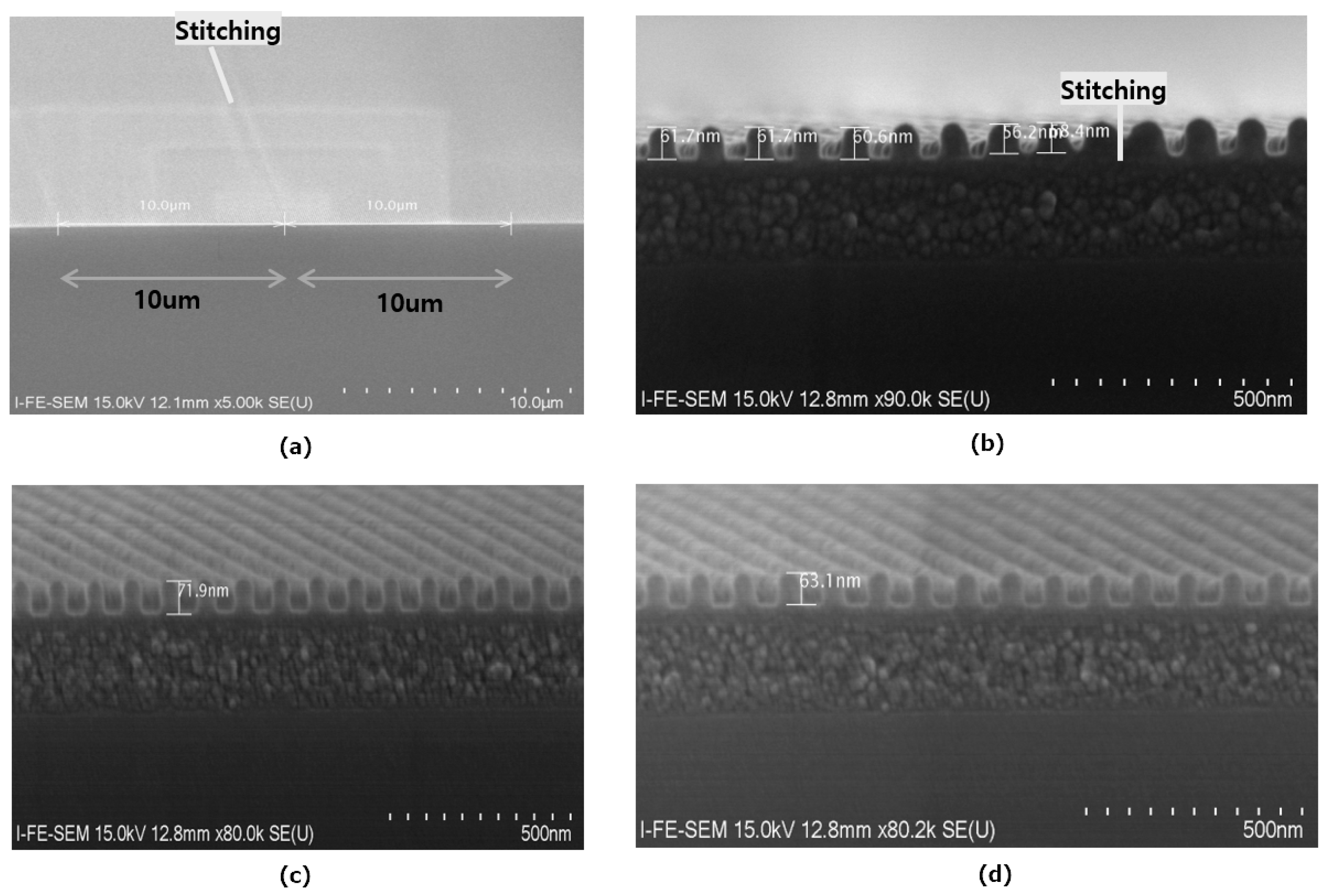

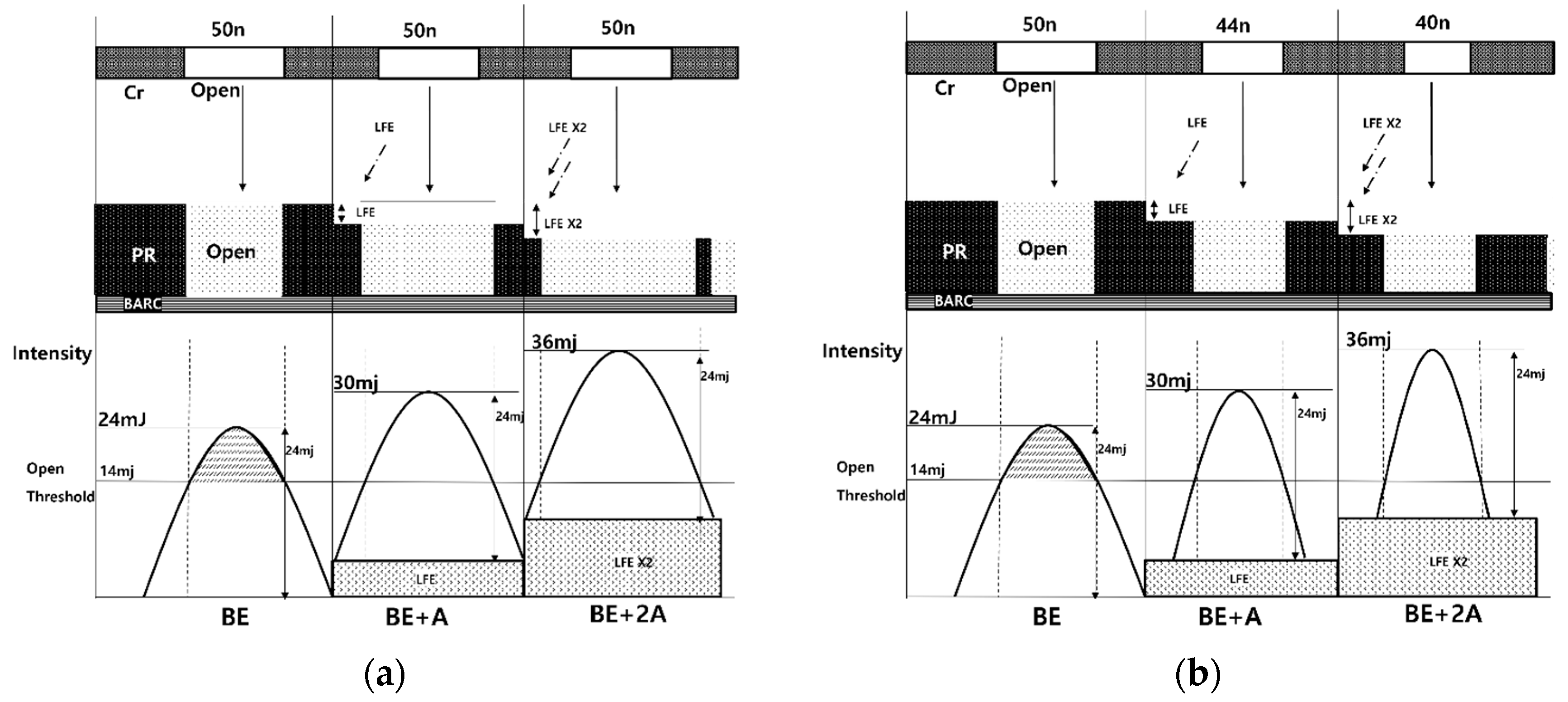

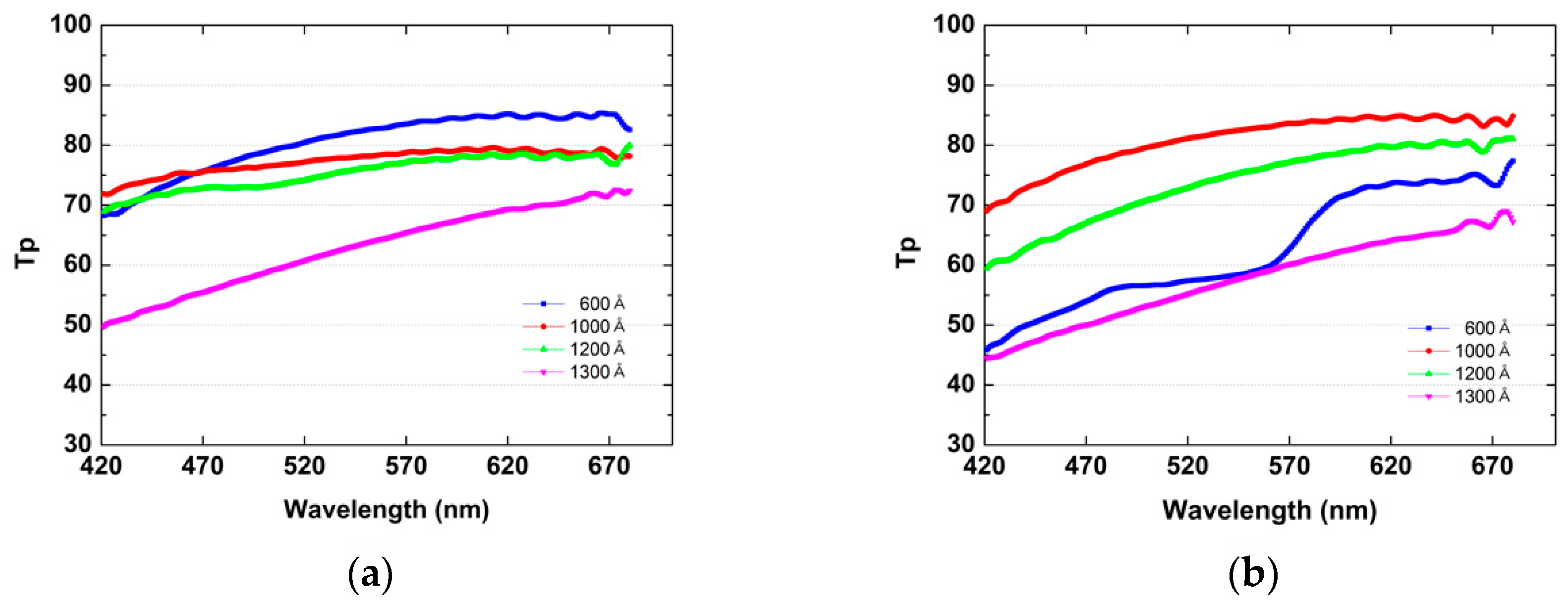

| 450 nm (420~500) | 550 nm (500~590) | 650 nm (610~680) | ||||||
|---|---|---|---|---|---|---|---|---|
| Tp (%) | Ts (%) | CR | Tp (%) | Ts (%) | CR | Tp (%) | Ts (%) | CR |
| 73.0 | 0.37 | 199 | 82.52 | 0.18 | 448 | 84.68 | 0.12 | 699 |
Publisher’s Note: MDPI stays neutral with regard to jurisdictional claims in published maps and institutional affiliations. |
© 2022 by the authors. Licensee MDPI, Basel, Switzerland. This article is an open access article distributed under the terms and conditions of the Creative Commons Attribution (CC BY) license (https://creativecommons.org/licenses/by/4.0/).
Share and Cite
Song, J.; Oh, J.S.; Bak, M.J.; Kang, I.-S.; Lee, S.J.; Lee, G.-W. 300 mm Large Area Wire Grid Polarizers with 50 nm Half-Pitch by ArF Immersion Lithography. Nanomaterials 2022, 12, 481. https://doi.org/10.3390/nano12030481
Song J, Oh JS, Bak MJ, Kang I-S, Lee SJ, Lee G-W. 300 mm Large Area Wire Grid Polarizers with 50 nm Half-Pitch by ArF Immersion Lithography. Nanomaterials. 2022; 12(3):481. https://doi.org/10.3390/nano12030481
Chicago/Turabian StyleSong, Jungchul, Jae Sub Oh, Min Jun Bak, Il-Suk Kang, Sung Jung Lee, and Ga-Won Lee. 2022. "300 mm Large Area Wire Grid Polarizers with 50 nm Half-Pitch by ArF Immersion Lithography" Nanomaterials 12, no. 3: 481. https://doi.org/10.3390/nano12030481






